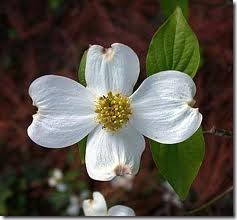Flowering Dogwood, bearing the scientific name "cornus florida," has become America’s most popular ornamental tree. Native to North America, the Latin "cornus florida" translates to "flowering horn." The showy tree is preferred among homeowners and landscapers for its multi-seasonal interest and ability to attract wildlife. Through the process of propagation, a variety of cultivars have been introduced, offering subspecies in differing heights and flower color.
Size
-
The potential size of the Flowering Dogwood is dependent on the light conditions of the planting site, as well as the species. Mature height can reach 20 to 35 feet with a canopy spread of 25 to 30 feet at maturity. It is more common to find trees in the 15 to 20 foot range. Adding 13 to 24 inches of new growth per year, the tree is classified as a moderate grower, with an average lifespan of 125 years.
Identify
-
 White Flowering Dogwood
White Flowering DogwoodThe Flowering Dogwood is easily identifiable in the spring when brilliant flowers of white, pink or red cover the canopy. Clustering, bright red fruits first appear in late spring and continue ripening through late summer, turning glossy by the winter months. Deciduous green foliage turns dark scarlet and purple in the fall. The crimson winter bark and twigs add interest to the landscape.
Soil and Light
-
The shallow root system is susceptible to rot in wet soil. Rich, adequately draining soil of clay or sand allows the tree to thrive. Light requirements are flexible from areas of shade to full sun but will produce different results. Shade trees grow taller but will be less dense with fewer flowers. Ideally, a site with partial shade or dappled sun and moist soil is the perfect choice for optimal growing conditions.
Pruning
-
Naturally a multi-stemmed tree, the Flowering Dogwood can be trained into one central trunk. The round-shaped symmetrical crown requires minimal pruning. With age, graceful drooping of lower branches is common and may initiate trimming.
Benefits
-
 Dogwood berries
Dogwood berriesIn addition to adding beauty, the Flowering Dogwood is beneficial to its local ecosystem. The seed, fruit, flowers, leaves, twigs and bark are consumed by a host of animals. The trees rapidly decomposing litter helps to improve the quality of surrounding soil. The light, close grained lumber has been used to make tools, gold heads and in basket-weaving. A red dye can be produced by boiling the bark and twigs.
Varieties
-
Thanks to the diverse subspecies, it is easy for gardeners to choose a suitable dogwood. Japanese versions of the tree, called "kousa," grow smaller in height and are resistant to some fungi. Vigorous dogwood shrubs can tolerate colder temperatures and offer some deer resistance. Dense growing patterns make them an excellent choice as a hedge.


Deprecated: strpos(): Passing null to parameter #1 ($haystack) of type string is deprecated in /home/agriviek8Qv/agriviet.net/public_html/wp-includes/comment-template.php on line 2522